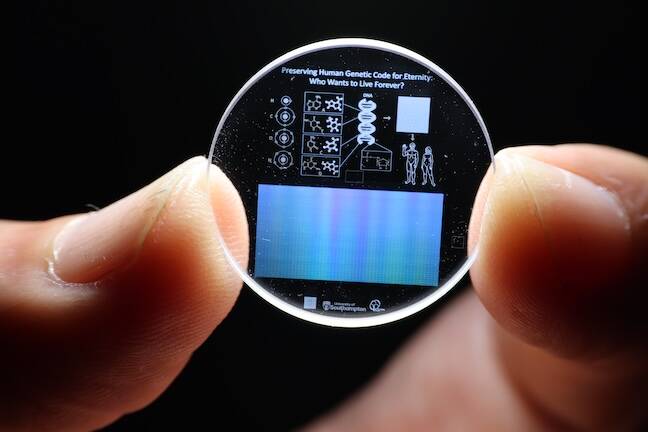
Whether or not some future entity will want to bring humanity back after its eventual extinction is now a theoretical if improbable option, thanks to boffins at the University of Southampton in the UK. Researchers led by optoelectronics professor Peter Kazansky have used an ultra-fast laser to inscribe the human genome in a 5D memory crystal , a storage medium designed to last billions of years. Earth's deoxygenation is expected sooner than that, in about one billion years , and the Sun is expected to swallow our planet in about 7.
6 billion years. But at least it's comforting to know that human genomic data will be protected from bit rot, the degradation of data that has already devoured early digital artifacts. Our genetic blueprint will be notionally recoverable for a very long time if not eternally, as was suggested in a 2016 research paper co-authored by Kazansky.

What that 5D memory crystal looks like ...
Source: Prof Kazansky. Click to enlarge The idea of optical storage using an ultra-fast laser and a transparent medium dates back to 1996 [PDF]. What's changed since then is that the write speed for this process no longer takes an eternity or something like it.
"If ten years ago it took us half a year to write the data, now we can write it in one hour," Kazansky told The Register on Friday. 5D memory crystal is not really crystal. "It's silica glass," Kazansky said.
"It's not like the glass in windows. It's similar to what's used in fiber. It's very pure silica, and it's very durable.
" It's tougher even than tardigrades. The fused silica can withstand temperatures of up to 1000°C, force up to 10 tons per cm 2 , and cosmic radiation. Developed by the University of Southampton’s Optoelectronics Research Centre (ORC), 5D memory crystals come in various sizes, the largest of which, a 5-inch square, can store 360 terabytes of data for longer than anyone will be around to care.
The 5D designation refers to the degrees of freedom, or dimensions, used to write the data. "Three degrees of freedom are X, Y, and Z coordinates, then we have the orientation of the nanostructure and its size," Kazansky explained, referring to the polarization state and wavelength. The data writing process involves shining a femtosecond laser at the fused silica storage medium to create pits that contain "nanograting," structures as small as 20nm that refract light.
The 5D memory crystals can also accommodate high-resolution graphics, so instructions for post-apocalypse re-industrialization, semiconductor competency, and optical engineering are available to those who might want to read the data but lack the necessary tools. Kazansky's team enlisted Helixworks Technologies to sequence each of the roughly three billion letters in the human genome 150 times to ensure positional accuracy. And the resulting 5D memory crystal has been placed with the Memory of Mankind archive, which resides in a salt cave in Hallstatt, Austria.
"Our goal is to create a backup of humanity’s genetic code in case of a catastrophic event," explained Kazansky. "The 5D memory crystal’s exceptional durability ensures that this information can be preserved for billions of years, outlasting our species." Kazansky said beyond safeguarding humanity's genetic blueprint, another motivation is the possibility of reconstructing an individual person.
"While current technology doesn’t allow for recreating a person from DNA alone, advances in synthetic biology, like Dr Craig Venter’s creation of a synthetic bacterium, suggest that this could become possible," he said. "By storing the human genome, we provide a foundation for future researchers to explore such possibilities." "Nature has spent millions of years perfecting the DNA that underlies life," said Kazansky.
"With this technology, we are not only safeguarding humanity's legacy but also preserving the potential for future restoration and understanding of what makes us human." While we ponder the list of awful people we'd prefer not to be recreated in some future Matrix, there are more immediate applications of 5D memory crystals. Microsoft, which collaborated with the University of Southampton on the technology, has been talking up Project Silica , its own data archiving project, since 2017.
Kazansky, whose work is cited in Microsoft's paper [PDF] on the project, has just launched a spin-off venture called SPhotonix LLC to bring the technology to market. The company's website, we're told, will debut next week and the immediate focus will be on raising funds to sustain the venture. ®.













